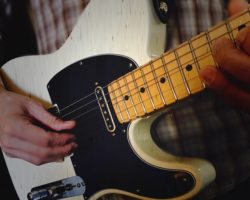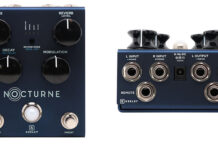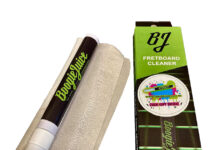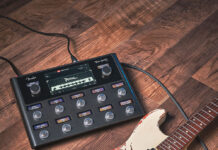
How to Create Professional-Sounding Tracks at Home
Hello, kids.
Every producer has his or her secrets. Some use gear, like a certain mic or pre or vintage amp to get a signature sound.
Sometimes it’s studio trickery. I just like to think of it as being in control of the studio space and the tools at hand.
Sometimes the most obvious tracking methods are overlooked by the casual observer. Here are some of those tips. I guarantee a better sound by applying these simple methods. You might even discover your own signature sound!
01. GAIN STAGING: The guitar goes into the amp or modeler. Then, if it is a modeler, does it go directly into your converter or into a preamp? If it is a preamp, it will leave the pre and then hit the converter before the computer. If the guitar went to an amp, then the amp is mic’d up.
The mic signal goes into a pr-amp. The preamp may then go into a compressor. After that, it is off to the converter before the computer. Simple, right? But how is the signal from one piece of the chain to the next? This is called gain staging. Each should be strong and balanced without any weakness or overloads. Be sure to check the gain in each stage (And use quality cables).
02. EVENNESS OF SOUND: This is the most important of my considerations when I am tracking for a client or myself. I like to hear a balance of top, mid and bottom in the character of the one. This way it becomes incredibly flexible when it’s time to mix. Use your ears and really hear the sound. Is it muddy on the bottom? Too shrill? Scooped in the mids? Don’t be lazy. Make any and all adjustments. You’ll be happy you did.
03. CREATING NATURAL THICKNESS: We all double track. Big-sounding guitars panned hard left and right. But how many create an extra layer of natural thickness by doubling each of those parts with another layer de-tuned slightly? And please don’t think using your computer to de-tune it a little is the same because it is not! Play it again. Re-tune a few cents off for each new part.
The added extra performance will also help if it is slightly off here and there. You are supposed to be musicians and not computer geeks! Work! Play it again! By the way, this works incredibly well on acoustic guitars, too.
04. CONSIDER THE ENVIRONMENT: Are you tracking all your guitars using the same amp? How about the same mic? How about the same speaker? And you leave them all in the same position in the same room for every track on the song. Dude…no good!
If you have only one mic, one guitar and one amp, you can still vary the mic position. Sometimes radically. Or the position on the cone of the mic. Or take the amp into a different room and track from there! And if you are only using a modeling amp, then you can still make the same considerations! Add a room sound, early reflection or mic position in the modeler. I love the combination of tracks using amps and modelers.
05. DEFINITION: Do your tracks sound sloppy? Muddy? Distortion is a temptress. Too much juice can be incredible! But not necessarily in the studio. Cut back on the gain by at least 20 percent on the rhythm parts. Then try adding uber-clean guitar tracks playing the same parts and tuck them in so they are just barely audible! This will add definition to your dense, fast metal tracks and the added benefit of actually hearing some tone come into your sonic landscape!
06. MULTI-MIC: I do not believe any one microphone can capture all of the guitar sound. That being said, the most common combination is the dynamic mic and a ribbon. The dynamic captures the bite while the ribbon captures the body. Invest in your own mics. The combo does not cost any more than another good guitar. And as sexy as those preamps look in the studio, the mics are more obvious to your ears. But a couple of good pre’s are certainly not going to hurt you in any way.
And here’s the big one; I’ve saved the best for last. This will make your solo stand out in any song more than any tip you will ever find.
07. MODULATE AND COMPOSE: How many of you solo over the verse? Gee, that’s exciting! Play something boring over the same part that has already been repeated. How about writing a new part, modulated up to a new key (I like a minor 3rd), vary the rhythm and chords to a new groove and watch the solo jump out! It will be like a breath of fresh air in an overcrowded room with a boring speaker! And no piece of gear or studio can fix a bad composition or add energy to a boring composition.
Seriously, I could do a whole column on this alone…hmmm?
Till next time…
Ron Zabrocki is a session guitarist from New York, now living in Connecticut. Says Ron: “I started playing at age 6, sight reading right off the bat. That’s how I was taught, so I just thought everyone started that way. I could sight read anything within a few years, and that helped me become a session guy later in life. I took lessons from anyone I could find and had some wonderful instructors, including John Scofield, Joe Pass and Alan DeMausse. I’ve played several jingle sessions (and have written a few along the way). I’ve “ghosted” for a few people who shall remain nameless, but they get the credit and I get the money! I’ve played sessions in every style, from pop to jazz.
Source: www.guitarworld.com











